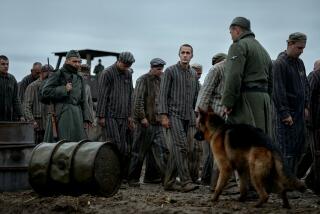Has He Forgotten Anything? : THE THINGS THEY CARRIED <i> by Tim O’Brien (Houghton Mifflin/ Seymour Lawrence: $18.95; 273 pp.) </i>
- Share via
Why is he still writing about the Vietnam War, Tim O’Brien imagines a child asking him. Why not write about a little girl who finds a million dollars and spends it on a Shetland pony?
The reader may ask the same question, though probably not about the pony. Writing that commands the graceful and unsparing strength that O’Brien used in “Going After Cacciato” a dozen years ago is rare. How we need writers to give us an equivalent strength and discrimination for the more inchoate puzzlement of our own days!
O’Brien, whose reflections and comments run through this new chain of Vietnam stories, faces the question. He takes it up, puts it down, takes it up again. He tells us that you get your material where you find it. That’s off-hand, even crude. Then, later:
“I’m 43 years old and I’m still writing war stories. . . . The remembering makes it now. And sometimes remembering will lead to a story which makes it forever. That’s what stories are for. Stories are for joining the past and the present.”
If you are in prison, you write to get out; O’Brien’s memories still encircle him. But the fuller justification for “The Things They Carried” is the writing itself. Some of it does seem like the most acute of second thoughts. Some of the less interesting pieces do seem like a harking-back in order to re-live the extra aliveness that came with the horrors.
But the best of these stories--and none is written with less than the sharp edge of a honed vision--are memory as prophecy. They tell us not where we were but where we are; and perhaps where we will be.
O’Brien draws upon his own experience in Vietnam, of course, but the characters and incidents are fictional, he writes. He casts himself, though, both as a fictional member of the platoon where the stories are set and as the narrator meditating upon them years later.
His voice advances, halts, doubles back. An incident will be told in two or three different ways; it will be interrupted, it will peter out, and resume. Sometimes it will deny some of what it has told us, or tell us that it happened differently.
“How to Tell a Story in Wartime” is the title of one set of story fragments, reflections and comments. A story cannot be told straight, it informs us. What is to be told is so hideous, unpredictable and absurd that the narrator has to manipulate it, duck away and invent. In war, you tell a story to escape or change the thing you have to tell.
These 19- and 20-year-olds, plucked from their ordinary lives and hijacked into a nightmare, have to invent themselves as well as their stories. Jensen and Strunk get into a fight over a jackknife; Jensen smashes Strunk’s nose so badly he needs to be hospitalized. When Strunk returns a few days later, Jensen begins to worry that he may use one of innumerable opportunities to kill him. He breaks his own nose with his pistol butt; now they’re even.
Not only are they even, but they are buddies. They sign a contract that if either is so badly wounded as to become a wheelchair case, the other will kill him. Strunk’s leg is blown off; Jensen comes over to comfort him. “Don’t kill me,” Strunk begs. “Swear you won’t kill me.” Jensen swears. All this is told, in fact, in two successive stories, the first called “Enemies,” the second “Friends.” The two, in this unhinging light, are synonymous.
A patrol goes up to a highland to stay a week and listen for enemy activity. It is foggy up there; listen is all they can do. And they begin to hear music: string quartets, choirs, the tinkling glasses and chatter of a cocktail party. One of the patrol describes it to the narrator:
“The rock--it’s talking. And the fog too, and the grass and the goddamn mongooses. Everything talks. The trees talk politics, the monkeys talk religion. The whole country. Vietnam. The place talks. It talks. Understand? Nam--it truly talks.”
They radio for air strikes; all night long, the empty hill is hit with napalm, incendiaries, fragmentation bombs. It is irrational and utterly rational at the same time. To these farm and city boys, all explanations of why they are there are no less imaginary than the hills talking.
There is beastliness, and there are odd, invented moralities. The platoon goes through a village where an air strike has silenced everything. Only a 14-year-old girl is left, dancing crazily outside the house where her dead parents lie. That night, one of the soldiers does an obscene burlesque of her movements. “Dance right,” another screams at him.
The most extraordinary piece in the collection is the first, which bears its title. “What They Carried” begins as nothing but a list, it seems. It is a list of everything that the members of a platoon carry, and the weight of each item.
Knives, heat tabs, wristwatches, dog tags, mosquito repellent, chewing gum, candy, salt tablets, packets of Koolade, C-rations, water and so on--15 to 20 pounds. Helmets--5 pounds. Boots--2.1 pounds. Rifle--8.2 pounds, loaded. Extra ammunition, 14 pounds. Grenade launcher, 5.9 pounds. Twenty-five grenades--16 pounds. A machine gun--23 pounds. A medic’s kit--20 pounds. And then a host of individual choices: foot powder, canned peaches, comic books, condoms, dope, a Bible, a slingshot, brass knuckles. And much more.
O’Brien goes on and on, gradually extending the verb “to carry.”
The soldiers carry love letters, photos, fungus, lice and each other when wounded. They carry lucky charms and the thoughts they cling to. They carry grief, terror, confusion. And gradually, a haunting picture is assembled.
They are as heavily equipped as Tweedledum and Tweedledee. Each item has its purpose: for killing, protecting, preserving. Yet all the purposes add up to a grotesque purposelessness. These soldiers are not so much warriors as carriers of war, pack mules on which firepower is placed and among which a terrible mortality is inflicted. This absurd cargo of purposes they carry through a land and a war from which they are utterly divorced, and through which they move in a state between dream and nightmare.
It is an ultimate, indelible image of war in our time, and in time to come.
More to Read
Sign up for our Book Club newsletter
Get the latest news, events and more from the Los Angeles Times Book Club, and help us get L.A. reading and talking.
You may occasionally receive promotional content from the Los Angeles Times.






